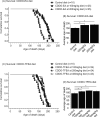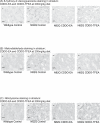Triterpenoids CDDO-ethyl amide and CDDO-trifluoroethyl amide improve the behavioral phenotype and brain pathology in a transgenic mouse model of Huntington's disease
- PMID: 20338236
- PMCID: PMC2916021
- DOI: 10.1016/j.freeradbiomed.2010.03.017
Triterpenoids CDDO-ethyl amide and CDDO-trifluoroethyl amide improve the behavioral phenotype and brain pathology in a transgenic mouse model of Huntington's disease
Abstract
Oxidative stress is a prominent feature of Huntington's disease (HD) due to mitochondrial dysfunction and the ensuing overproduction of reactive oxygen species (ROS). This phenomenon ultimately contributes to cognitive and motor impairment, as well as brain pathology, especially in the striatum. Targeting the transcription of the endogenous antioxidant machinery could be a promising therapeutic approach. The NF-E2-related factor-2 (Nrf2)/antioxidant response element (ARE) signaling pathway is an important pathway involved in antioxidant and anti-inflammatory responses. Synthetic triterpenoids, which are derived from 2-Cyano-3,12-Dioxooleana-1,9-Dien-28-Oic acid (CDDO) activate the Nrf2/ARE pathway and reduce oxidative stress in animal models of neurodegenerative diseases. We investigated the effects of CDDO-ethyl amide (CDDO-EA) and CDDO-trifluoroethyl amide (CDDO-TFEA) in N171-82Q mice, a transgenic mouse model of HD. CDDO-EA or CDDO-TFEA were administered in the diet at various concentrations, starting at 30days of age. CDDO-EA and CDDO-TFEA upregulated Nrf2/ARE induced genes in the brain and peripheral tissues, reduced oxidative stress, improved motor impairment and increased longevity. They also rescued striatal atrophy in the brain and vacuolation in the brown adipose tissue. Therefore compounds targeting the Nrf2/ARE pathway show great promise for the treatment of HD.
Copyright 2010 Elsevier Inc. All rights reserved.
Figures






Comment in
-
The Nrf2 pathway as a potential therapeutic target for Huntington disease A commentary on "Triterpenoids CDDO-ethyl amide and CDDO-trifluoroethyl amide improve the behavioral phenotype and brain pathology in a transgenic mouse model of Huntington disease".Free Radic Biol Med. 2010 Jul 15;49(2):144-6. doi: 10.1016/j.freeradbiomed.2010.04.009. Epub 2010 Apr 24. Free Radic Biol Med. 2010. PMID: 20399852 No abstract available.
References
-
- Halliday GM, McRitchie DA, Macdonald V, Double KL, Trent RJ, McCusker E. Regional specificity of brain atrophy in Huntington's disease. Exp Neurol. 1998;154(2):663–672. - PubMed
-
- Vonsattel JP, Myers RH, Stevens TJ, Ferrante RJ, Bird ED, Richardson EP., Jr Neuropathological classification of Huntington's disease. J Neuropathol Exp Neurol. 1985;44(6):559–577. - PubMed
-
- Sorolla MA, Reverter-Branchat G, Tamarit J, Ferrer I, Ros J, Cabiscol E. Proteomic and oxidative stress analysis in human brain samples of Huntington disease. Free Radic Biol Med. 2008;45(5):667–678. - PubMed
-
- Browne SE, Beal MF. Oxidative damage in Huntington's disease pathogenesis. Antioxid Redox Signal. 2006;8(11-12):2061–2073. - PubMed
Publication types
MeSH terms
Substances
Grants and funding
LinkOut - more resources
Full Text Sources
Other Literature Sources
Medical

